
Wasps are insects in the Hymenoptera order and the Apocrita sub-order. They are notorious for their poisonous stings that may cause swelling or even anaphylactic shock in case of allergic people.
Wasps are commonly confused with bees, but still there are some specific features that make them different. Their bodies and legs are slender and smooth with relatively few hairs. They have a narrow “waist” called a petiole and a sting that can be used multiple times.
Wasps inhabit almost every part of the world except for the polar regions. Their colors vary from black with yellow stripes to bright red and metallic green. The size ranges from 0.0055 up to 2 inches.
Wasp species are subdivided into social and solitary. Social wasps live in colonies making nests of chewed wood and plants. Their nests are inhabited by up to 10,000 individuals. They are represented by queens, workers and males called drones. Generally, wasps live no longer than 12-22 days and only fertilized queens stay alive for winter hibernating in warm places (such as walls of buildings, hollows of trees etc.) to give birth the following year. In spring the queen crawls out, builds a small nest to lay a few eggs that hatch into workers. They do the rest of the work while the queen continues laying eggs. The new born workers expand the nest and feed the larvae.
Solitary wasps live alone and never gather in colonies. They make the vast majority of wasp species. Solitary wasps lay eggs and leave them alone to hatch either in the nests built for their own offspring only and foraged for food or in wood and even other insects.
Being omnivorous insects, wasps eat not only nectar, honey, fruits but other insects as well. They travel up to half a kilometer from their nests in search of food. Yet, wasps can also be very useful when it comes to protecting crops from pest insects in agriculture industry.
Worldwide there are more than 75,000 identified species of wasps. However, there are 3 main types of wasps that are most commonly encountered by pest control professionals: paper wasps, hornets and yellow jackets.
Wasp Species
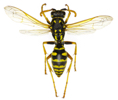 Paper Wasp is probably the most wide-spread species of wasps (0.75- 1.5 inches long social wasp with a black body having yellow markings, a very thing “waist” and distinctive long legs). The nest, usually made for 5-30 wasps, looks like a turned upside-down umbrella with the open cells seen from below. Paper wasps will build their nests in trees or shrubs in a yard, attics, fences or on the exterior of a home. Paper wasp nests are water-resistant, made of grey or brown paper mache-like material.
Paper Wasp is probably the most wide-spread species of wasps (0.75- 1.5 inches long social wasp with a black body having yellow markings, a very thing “waist” and distinctive long legs). The nest, usually made for 5-30 wasps, looks like a turned upside-down umbrella with the open cells seen from below. Paper wasps will build their nests in trees or shrubs in a yard, attics, fences or on the exterior of a home. Paper wasp nests are water-resistant, made of grey or brown paper mache-like material.
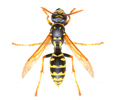 Yellow Jackets (up to 0.5 inches long social wasp) have a black body with bright yellow markings, black antennae and shorter legs. Their nests have multiple layers and are inhabited by up to 15,000 members. Yellow jackets build spherical nests that can grow to the size of a basketball or larger. Their nests are commonly found within wall voids or cavities in the ground. As for feeding, yellow jackets prefer eating other insects, but sometimes they may enjoy sugary foods.
Yellow Jackets (up to 0.5 inches long social wasp) have a black body with bright yellow markings, black antennae and shorter legs. Their nests have multiple layers and are inhabited by up to 15,000 members. Yellow jackets build spherical nests that can grow to the size of a basketball or larger. Their nests are commonly found within wall voids or cavities in the ground. As for feeding, yellow jackets prefer eating other insects, but sometimes they may enjoy sugary foods.
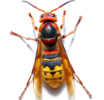 Hornets are the largest social wasps (Up to 2 inches long social wasp of the same color as Yellow Jackets but twice bigger in size). Hornets' appearance may vary in color from black and white to brownish or slightly reddish in color. Hornets usually prey on other insects, and very rarely dine on sweet food. The nest is usually ball-like built high in the air and is inhabited by up to 700 members less aggressive than Yellow Jackets, though their stings can be very painful. Pest control professionals encounter two main types of hornets - Bald faced hornets and European hornets. Bald faced hornets have white markings on their head and thorax with smoky black wings. Their nests are covered in a papery shell. European hornets are commonly brownish with orange markings. They build their nests in natural cavities like trees, stumps or in cavities within buildings.
Hornets are the largest social wasps (Up to 2 inches long social wasp of the same color as Yellow Jackets but twice bigger in size). Hornets' appearance may vary in color from black and white to brownish or slightly reddish in color. Hornets usually prey on other insects, and very rarely dine on sweet food. The nest is usually ball-like built high in the air and is inhabited by up to 700 members less aggressive than Yellow Jackets, though their stings can be very painful. Pest control professionals encounter two main types of hornets - Bald faced hornets and European hornets. Bald faced hornets have white markings on their head and thorax with smoky black wings. Their nests are covered in a papery shell. European hornets are commonly brownish with orange markings. They build their nests in natural cavities like trees, stumps or in cavities within buildings.
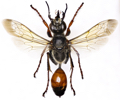 Ground Wasps, also referred as ground wasps, digger wasps or sand wasps, dig their nests underground. Great Golden Digger Wasp, Eastern Cicada Killers, Ground-Nesting Yellow jackets are some Ground Wasp species. They all sting but these wasps are not aggressive. Group wasp larvae are raised in the soil or in mud cell nests constructed by the female wasp. A female ground wasp will paralyze her prey, lay her eggs on the body of the host and let her larvae feed on it. Adult wasps usually feed on nectar and honeydew. Ground wasps are classified into solitary ground wasps and social ground wasps. Solitary ground wasps live alone, find food and build nests for themselves and larvae. Social ground wasps live and work as part of a big colony that has the queen and workers.
Ground Wasps, also referred as ground wasps, digger wasps or sand wasps, dig their nests underground. Great Golden Digger Wasp, Eastern Cicada Killers, Ground-Nesting Yellow jackets are some Ground Wasp species. They all sting but these wasps are not aggressive. Group wasp larvae are raised in the soil or in mud cell nests constructed by the female wasp. A female ground wasp will paralyze her prey, lay her eggs on the body of the host and let her larvae feed on it. Adult wasps usually feed on nectar and honeydew. Ground wasps are classified into solitary ground wasps and social ground wasps. Solitary ground wasps live alone, find food and build nests for themselves and larvae. Social ground wasps live and work as part of a big colony that has the queen and workers.
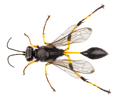 Mud Dauber is a common name for wasps that make their brood nests with mud. Their nests are usually small and consist of 3 to 20 tube-like cells made of mud. Mud dauber wasps are solitary insects. These types of wasps are colored either completely black or blue metallic or they may have yellow or greenish markings on the body. Their bodies are “thread-waisted” with an extremely long and thin body part located between the thorax and abdomen. Mud daubers are in fact quite beneficial as they help decrease the numbers of some pest insects and spiders. It's not typical of them being agressive, however, one should never mess with their nests around.
Mud Dauber is a common name for wasps that make their brood nests with mud. Their nests are usually small and consist of 3 to 20 tube-like cells made of mud. Mud dauber wasps are solitary insects. These types of wasps are colored either completely black or blue metallic or they may have yellow or greenish markings on the body. Their bodies are “thread-waisted” with an extremely long and thin body part located between the thorax and abdomen. Mud daubers are in fact quite beneficial as they help decrease the numbers of some pest insects and spiders. It's not typical of them being agressive, however, one should never mess with their nests around.
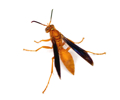 Red Wasps have reddish-brown bodies and heads with long blackish-purple wings and a brown stripe on their abdomen. They are social wasps, that is they live in colonies with a queen as their leader. Red wasps eat caterpillars, flies, bees, ants, spiders and sometimes other wasps. These wasps build elaborate, paper-like nests that can grow to massive proportions. Red wasps usually nest in the opening of trees, on porch ceilings, window and door frames, deck floors and attic rafters.
Red Wasps have reddish-brown bodies and heads with long blackish-purple wings and a brown stripe on their abdomen. They are social wasps, that is they live in colonies with a queen as their leader. Red wasps eat caterpillars, flies, bees, ants, spiders and sometimes other wasps. These wasps build elaborate, paper-like nests that can grow to massive proportions. Red wasps usually nest in the opening of trees, on porch ceilings, window and door frames, deck floors and attic rafters.
Wasp Control Toronto provides professional wasp nest removal and wasp nest control for residents of Toronto and the surrounding communities including greater Toronto area. If you noticed a wasp nest near or inside your house, call us today at 416-729-5657 or visit our Contact Us page to email us for quick and friendly service.
WE PROVIDE CONTROL FOR WASPS, BEES, HORNETS, YELLOW JACKETS, PAPER WASPS, MUD WASPS AND OTHER STINGING INSECTS FOR RESIDENTS OF TORONTO.

